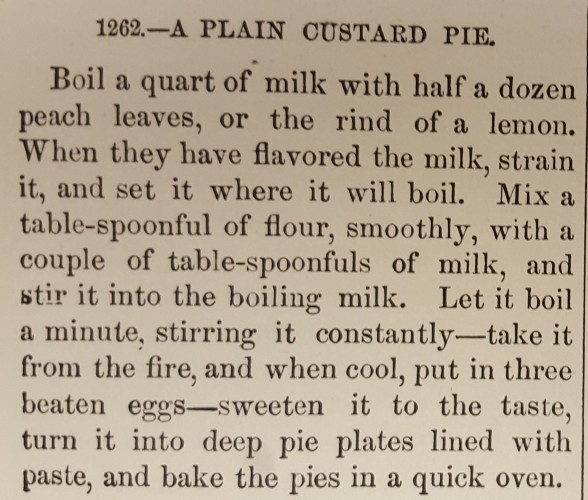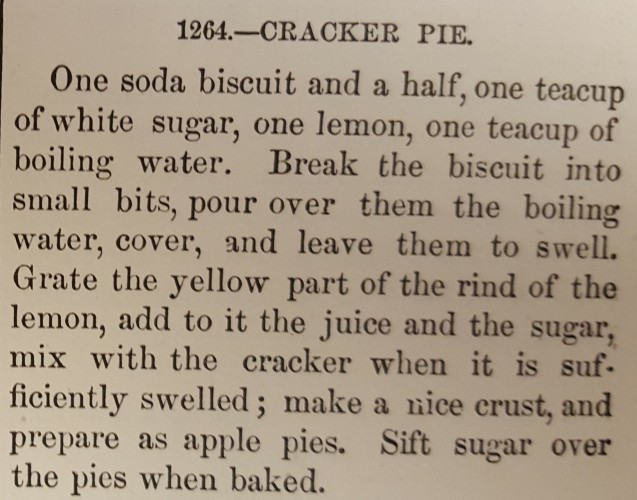For the past two years, the Special Collections Library has celebrated Pi Day (3/14) by sharing pie recipes from the Janice Bluestein Longone Culinary Archive (JBLCA). For past posts, see Pies for Pi Day (2015) and Mrs. Beeton's Pies for Pi Day (2016). This year, we bring you a pair of pies from The new cyclopaedia of domestic economy and practical housekeeper : adapted to all classes of society and comprising subjects connected with the interests of every family, such as domestic education, houses, furniture, duties of mistress, duties of domestics, the storeroom, marketing, table and attendance, care and training of children, care of the sick, preparation of food for children and invalids, preservation of health, domestic medicine, the art of cookery, perfumery, the toilet, cosmetics, and five thousand practical receipts and maxims : from the best English, French, German, and American sources : illustrated with over two hundred engravings (1872), edited by Elizabeth Fries Ellet. This is an updated and revised version of Ellet's earlier manual, The practical housekeeper : a cyclopædia of domestic economy ... comprising five thousand practical receipts and maxims, published in 1857.
Our first pie is "A Plain Custard," and in contrast to the lengthy title of this book, this pie recipe is quite short and sweet. Note that rather unusual suggestion to flavor the custard with peach leaves.

Elizabeth Fries Ellet. The new cyclopaedia of domestic economy and practical housekeeper... (Norwich, Conn.: Henry Bill Pub. Co., 1872). Special Collections Library, Janice Bluestein Longone Culinary Archive. Cookery 1872 El
1262. A PLAIN CUSTARD PIE.
Boil a quart of milk with half a dozen peach leaves, or the rind of a lemon. When they have flavored the milk, strain it, and set it where it will boil. Mix table-spoonful of flour, smoothly, with a couple table-spoonfuls of milk, and stir it into the boiling milk. Let it boil a minute, stirring it constantly - - take it from the fire, and when cool, put in three beaten eggs -- sweeten it to the taste, turn it into deep pie plates lined with paste, and bake the pies in a quick oven.
Note: Should you wish to try this recipe with your modern electric or gas oven, a "quick oven" is usually around 425 degrees Fahrenheit.
Faux apple pies were a fairly common 19th century solution to the need for a late-winter dessert (when fruit was in scarce supply) or a sweet treat on the budget. This version is simply titled Cracker Pie, after the main ingredient:

Elizabeth Fries Ellet. The new cyclopaedia of domestic economy and practical housekeeper... (Norwich, Conn.: Henry Bill Pub. Co., 1872). Special Collections Library, Janice Bluestein Longone Culinary Archive. Cookery 1872 El
1264. CRACKER PIE.
One soda biscuit and a half, one teacup of white sugar, one lemon, one teacup of boiling water. Break the biscuit into small bits, pour over them the boiling water, cover, and leave them to swell. Grate the yellow part of the rind of the lemon, add to it the juice and the sugar, mix with the cracker when it is sufficiently swelled; make a nice crust, and prepare as apple pies. Sift sugar over the pies when baked.
Note: In the 19th century, "soda biscuit" referred to a fairly plain, hard quick bread leavened by baking soda, poften between 1/2"-1" thick, significantly different from the "soda crackers" that we eat with soup today.
Wishing you all a very happy Pi/Pie Day!